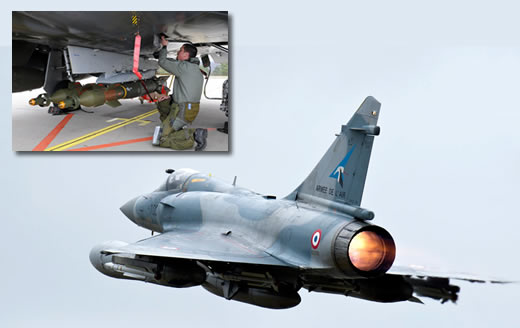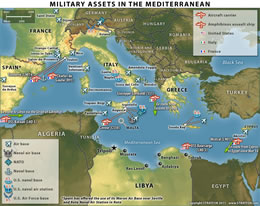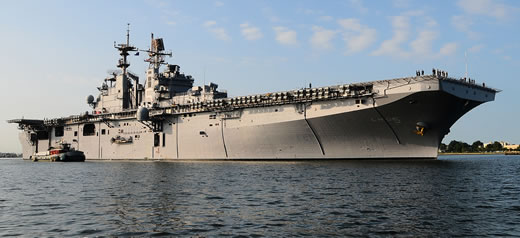
Last night the joint task force ‘Odyssey Dawn’, comprising U.S. Navy and Royal Navy surface ships and submarines launched a massive attack on Libya, firing 112 Tomahawk sea-launched cruise missiles. The missiles were fired from U.S. and British attack submarines and U.S. Navy surface ships. An airstrike with Storm Shadow cruise missiles was also launched by RAF Tornado GR4, flying straight from Marham airbase in the U.K., a 3,000 mile return flight. The attack targeted about 20 radar and anti-aircraft sites along Libya’s Mediterranean coast.


In addition to the cruise missiles, the United States will provide command and control and logistics. American airmen and sailors will also launch electronic attacks against the Libyan systems.
The United Kingdom, France, Italy and Canada already have announced that they are part of the coalition. Officials expect that some Arab countries may publicly announce their participation soon. Qatar is one of the Arab countries willing to send its airpower to take part in the operation.
Tha attack was part of the enforcement of United Nations Security Council Resolution (UNSCR) 1973 by implementing a ‘No Fly Zone’ over Libya. In preparation for this Resolution, NATO air forces have assembled air assets to southern Europe. Fighter aircraft, reconnaissance and surveillance planes, electronic attack, airborne early warning, aerial refueling and transport planes are all gathering here to assist and support the strike aircraft, attacking the Libyan air defenses, securing the airspace for NATO fighters enforcing the no fly zone act at relative security.

Before the current turmoil began Libya had an air defense network comprising SA-2 (GUIDELINE), SA-3 (GOA), and possibly SA-5 (S-200 GAMMON) protecting the main coastal air bases near Tripoli, Bengazi, Sirte and Tobruk. The Libyan military also operates mobile air defense assets, including SA-6 (GAINFUL), SA-9 (GASKIN / 9K31), SA-8 (GECKO / 9K33M3 Osa) and French Crotale air-defense missiles. Large numbers of MANPADS (SA-7), ZSU-23/4 and towed 23mm anti-aircraft cannons remain effective against low-flying aircraft, operated by Libyan government forces as well as by the rebels. Assuming these threats persist even after the static missile sites and their supporting assets (radars, command and control and reload missiles) are destroyed, these mobile and light air defenses will undoubtedly drive NATO fighters to operate and attack from high altitude, where identification of target could become an issue.

Libya’s air force is headquartered at Okba Ben Nafi Air Base, east of Tripoli. This airfield used to be the home of Libya’s MiG-25 interceptors. Many of these aircraft were seen in the open, mmostly as scrap. Few months ago the aircraft were moved elsewhere, along with some trainers previously positioned at the base. In satellite photos taken by mid-March 2011 only four MiG-23 fighters can be seen on the tarmac.
A large airbase at Sirte is colocated with a civil airfield. The military section at this base accomodates two squadrons of Su-22 based in individual hardened shelters and a helicopter squadron. These two airfields remained within Qadaffi’s forces control. Rebels have probably seized the large air base located at Benghazi International Airport, where MiG-23 were stationed. One of these aircraft flown by a pilot who joined the opposition was shot down by rebels on March 19, 2011. A third military base located southwest of Tobruk, (Gamal Abdul Nasser Air Base), is operating Mirage F1. Two air bases are located in the Sahara desert – at Al Kufrah Oasis and at Jabal al Uwaynat in the far south.

The Libyan air force is believed to operate about 370 mostly obsolete combat aircraft, including MiG-23s, MiG-25s, Su-22, Su-24 ‘Fencer D’s, Su-27s and Mirage F.1EDs. A squadron of Tu-22 bombers is believed to be posiytioned Okba Ben Nafi Airbase in the Sahara. Libya’s air force is organized into one medium bomber squadron, three fighter interceptor squadrons, five forward ground attack squadrons, one counterinsurgency squadron, nine helicopter squadrons, and three air defense brigades.
NATO has scrambled Spanish F/A-18s and Belgian F-16 fighter planes are also due to arrive in Italy. Six F-16s of the Danish Air Force are already positioned in Sigonella airbase in Sicily, where the U.S. Air Force has already stationed a Global Hawk unmanned Aircraft unit since September. The Italian air force has dispatched Tornado and Eurofighter aircraft to its Trapani air base in western Sicily in readiness. Aviano Air Base in Northern Italy is also suporting the operation, operating F/A-18s, C-17s and C-130 cargo planes. The British RAF deployed tonight about 20 Tornado GR4 strike fighters from Marham and Typhoon strike fighters from Coningsby. Four fighters from the Qatar Air Force are expected to join the task force soon, representing the first active Arab support for the operation.

A preliminary phase of Operation Odyssey Dawn was conducted by the French Air Force, which launched a ‘pre-strike’ at 17:45 on Saturday March 19, 2011 against Libyan military vehicles near in the Benghazi. This attack may have served as a ‘stimulation’ action bringing Libyan radars online, thus identifying them for the follow-on attack by the cruise missiles.
According to news reports, the French jets destroyed several tanks, believed to be operating with Lybian Army forces. The strike force included some 20 French Air Force aircraft, including six Rafale strike fighters from Saint-Dizier Air Force Base, two Mirage 2000D from Nancy and three Mirage 2000-5 from Dijon. Other support elements in the strike force included C-135 tankers from Istres and E-3F Airborne Warning and Control Systems (AWACS) from Alvor. These AWACS planes have been patrolling the southern Mediterranean off the Libyan coast for days, collecting intelligence and monitoring Libyan air activity in the area.
At sea, 25 ships from the U.S., Italy, Canada, the United Kingdom and France are taking part in the operation. Among these vessels are several ‘Los Angeles’ class submarines USS Prominence, Stranton, and Florida and Royal Navy Trafalgar class attack submarines, French aircraft carrier Charles de Gaulle had also deployed to the area wit Marine Rafale strike fighters and helicopters on board. The Royal Navy has two frigates in the area.

The U.S. Navy has deployed the Mediterranean ARG commanded by the amphibious assault ship USS Kearsarge which deployed to the area by early March, and is sending another group to the Mediterranean, to join the JTF operating. The Bataan ARG will deploy March 23 as part of U.S. maritime forces supporting U.S. and international contingency planning associated with the crisis in Libya. The Bataan ARG is made up of amphibious assault ship USS Bataan (LHD 5), amphibious transport dock ship USS Mesa Verde (LPD 19) and dock landing ship USS Whidbey Island (LSD 41). These vessels are typically carrying AV-8B attack aircraft, as well as attack, assault and transport heliopters.
the ARG and the Marine Expeditionary Unit (MEU) on board are prepared to conduct a variety of missions, including forward naval presence, maritime security operations, theater security cooperation, humanitarian assistance and disaster response, as directed by fleet and joint task force commanders.
Joint Task Force Odyssey Dawn is the U.S. Africa Command task force established to provide operational and tactical command and control of U.S. military forces supporting the international response to the unrest in Libya and enforcement of United Nations Security Council Resolution (UNSCR) 1973. This is the first combat operation to be commanded by the newly established Africa Command. JTF Odyssey Dawn is commanded by U.S. Navy Adm. Samuel J. Locklear aboard the command ship USS Mount Whitney.



















